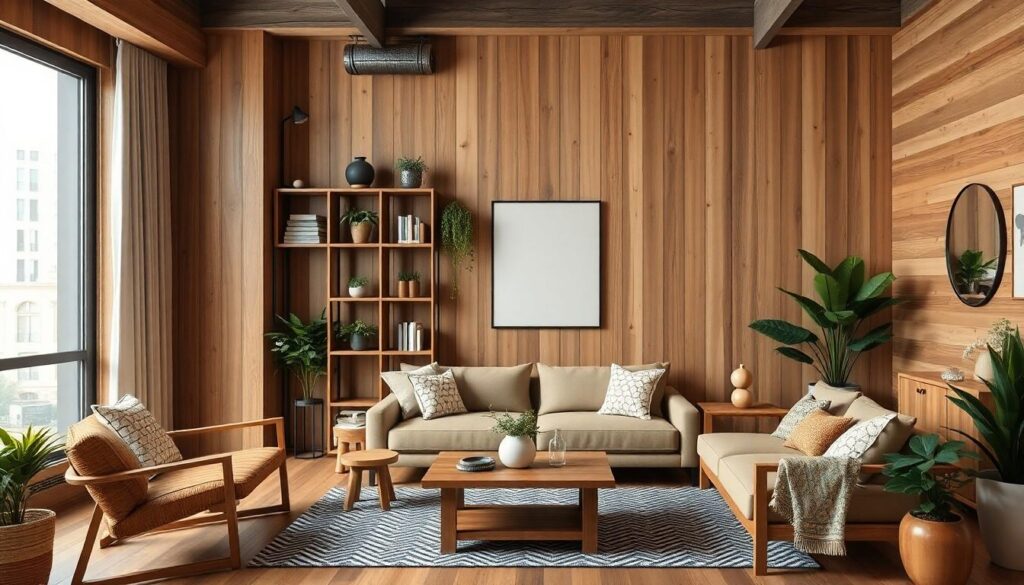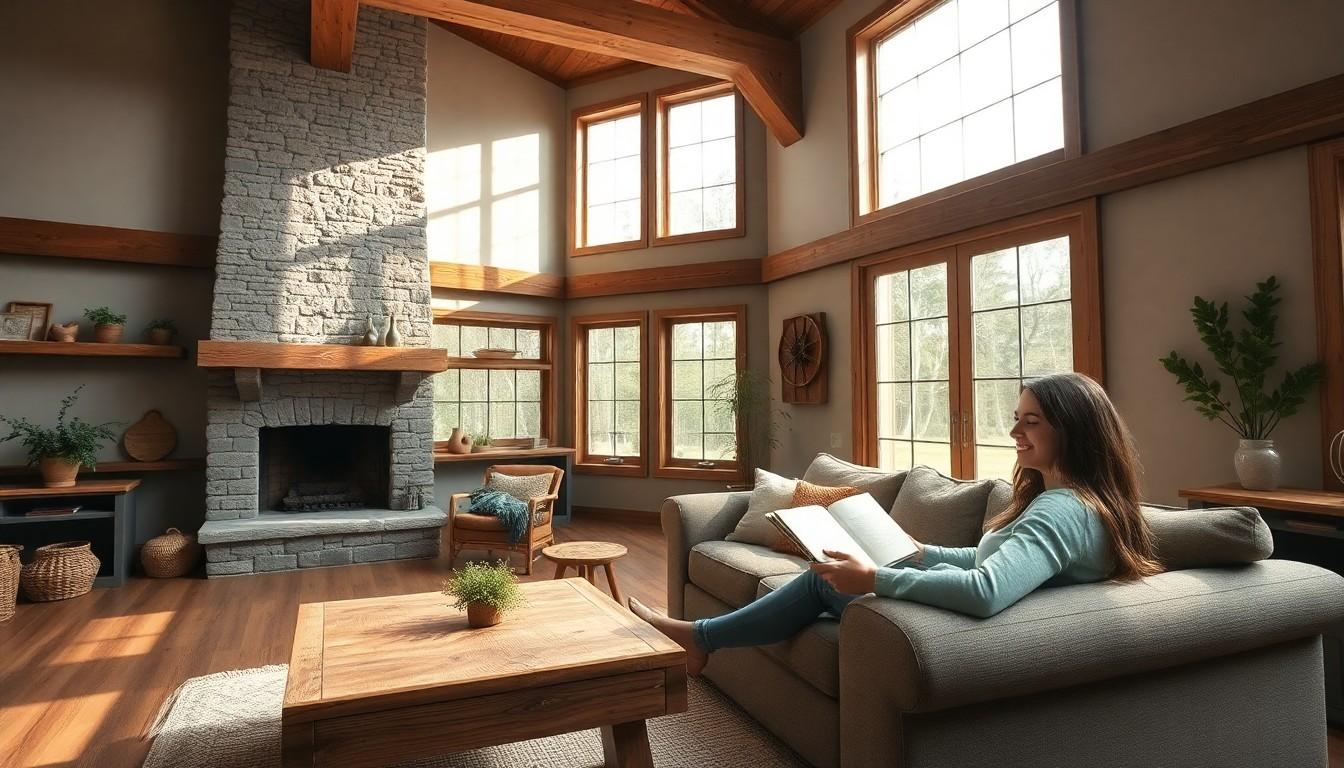Modern farmhouse interior design blends the warmth of traditional rural living with contemporary sensibilities. It’s a style that celebrates natural materials like wood, stone, and metal while embracing functional spaces that serve today’s lifestyle needs.
With its pitched roofs, clean lines, and wraparound porches on the outside, the modern farmhouse creates an inviting atmosphere that connects us to traditional values.
What makes this style so appealing is its thoughtful balance of rustic and contemporary elements.
You’ll find exposed wooden beams, plank flooring, and shiplap walls alongside updated materials and cleaner aesthetics. The modern farmhouse has transcended its rural origins to find a comfortable place in suburban and urban settings, offering a retreat from the hustle of city life while maintaining the comforts we’ve come to expect in our homes.
Bringing That Farmhouse Feel Home: Rural Charm for City Living
Farmhouse style creates a distinctive contrast with typical urban surroundings, offering city dwellers a retreat-like atmosphere without leaving town. This adaptable design approach brings natural materials and functional spaces to apartments and townhomes of all sizes.
The Story Behind Farmhouse Style
Farmhouse design wasn’t always trendy; it started as pure practicality. In the late 1800s, rural families built homes using whatever materials were available locally, focusing on durability and function rather than aesthetics.
Every element served a purpose related to agricultural life.
From Farm to Fabulous: How Practical Homes Became Design Icons
As cities grew more congested, farmhouses transformed from humble dwellings into desirable escapes. The upper classes began seeking countryside retreats, elevating these once-simple structures to status symbols.
What started as necessity evolved into a prestigious aesthetic, with farmhouses representing a blend of rustic charm and modern luxury. Today’s versions range from historically accurate reproductions to contemporary interpretations that merely nod to rural traditions.
What Makes a Farmhouse a Farmhouse?
The authentic farmhouse spirit lives in its honest materials and purposeful design.
These homes prioritize comfort and functionality, creating spaces where everything serves a purpose while maintaining an inviting, unpretentious atmosphere.
Look for wood with visible grain patterns, stone elements that showcase natural textures, and metal accents that develop character over time. True farmhouse style celebrates imperfections; distressed surfaces, weathered finishes, and signs of age are not hidden but highlighted.
Modern Farmhouse: Not Your Grandpa’s Barn

Modern farmhouse style has come a long way from the functional, practical farmhouses of yesteryear. This popular design trend gained momentum in the 1990s and absolutely exploded in the 2010s, offering a fresh take on rural charm with contemporary appeal.
Old vs. New: Spotting the Difference
You’ll know you’re looking at modern farmhouse design when you see deliberately weathered new pieces instead of actual antiques. Modern interpretations present a much more curated look; think carefully selected distressed furniture rather than Grandma’s mismatched collection that grew organically over decades.
You’ll find pristine white walls next to reclaimed wood, or industrial metal fixtures paired with cozy textiles—a thoughtful blend rather than true rural practicality.
The key difference? Modern farmhouse deliberately balances rustic elements with sleek contemporary pieces.
Architectural Features That Scream ‘Farmhouse’
Spotting modern farmhouse architecture is pretty straightforward once you know what to look for.
Shiplap walls add texture without feeling too rustic, while vaulted ceilings with exposed beams create dramatic visual interest. Large windows flood rooms with natural light, and white board and batten siding on exteriors completes the look that’s both timeless and fresh.
Inside, you’ll find generous doorways leading to connected living spaces rather than the small, compartmentalized rooms of traditional homes.
Those pitched roofs with clean lines and welcoming wraparound porches are dead giveaways.
Farmhouse in the ‘Burbs: Making It Work

Suburban farmhouse style brings character and warmth to neighborhoods that might otherwise feel a bit cookie-cutter. It’s all about finding that sweet spot; honoring traditional farmhouse elements while adapting them to fit standardized lot sizes and neighborhood contexts.
Standing Out Without Being the Weird House on the Block
You don’t have to go full barn-red to achieve farmhouse charm in the suburbs.
Your home can stand out with character while still feeling like it belongs in the neighborhood, distinctive but not disruptive.
Think refined versions of traditional elements that nod to the style without screaming “I belong on a 40-acre plot!” Open floor plans with thoughtful room divisions work beautifully in suburban settings, giving you that farmhouse flow while maintaining practical spaces for modern living. Designate areas for media centers and technology that blend seamlessly with more rustic elements.
Curb Appeal: Farmhouse Style from the Street View
From the street, your suburban farmhouse makes its statement through carefully chosen architectural details. Front-facing gables and covered porches immediately signal the farmhouse aesthetic, while vertical proportions distinguish your home from other suburban styles.
Complete the look with thoughtful landscaping using native plants and hardscaping elements like gravel paths or natural stone walls. These touches create a cohesive property that honors farmhouse tradition despite its suburban zip code.
Opt for durable, low-maintenance materials like fiber-cement siding that mimics traditional wood without the upkeep, and add metal roof accents for authentic character.
Urban Farmhouse: Country Living in the Concrete Jungle

Urban farmhouse design offers a counterbalance to hard city surfaces by introducing natural materials and handcrafted details that reference simpler lifestyles. It’s the most dramatic translation of farmhouse principles to densely developed environments, bringing warmth to urban spaces.
Why City Dwellers Are Falling for Farmhouse Style
City life bombards you with manufactured materials and commercial aesthetics at every turn. That’s why farmhouse style creates such a refreshing contrast in urban settings – it’s like a visual exhale.
Wood grain, handcrafted details, and comfortable spaces offer a psychological break from the concrete jungle, letting you experience those emotional benefits without leaving the city.
The natural rhythms and organic forms provide an “edgy-but-natural” appeal that acknowledges countryside inspiration while still embracing urban realities.
Small Space, Big Style: Farmhouse Solutions for Tight Quarters
Urban homes mean working with less square footage, but farmhouse style easily adapts with smart vertical thinking.
Corner spaces transform into built-in seating or storage nooks, while compact, multi-functional furniture pieces maintain the farmhouse feel without the bulk. The magic happens when you reference traditional forms while addressing contemporary urban needs – proving this style doesn’t depend on square footage but on comfort, authenticity, and natural materials.
Try exposed ceiling structures to draw the eye upward or install tall cabinets that maximize storage without expanding your footprint. Wall treatments like partial-height shiplap or board-and-batten detailing add character without overwhelming small rooms.
Getting the Farmhouse Look: Practical How-To’s
Creating the perfect modern farmhouse interior starts with thoughtful material selections that establish the foundation for your overall aesthetic. Let’s break down the key elements you’ll need to bring this warm, inviting style into your home.
Materials and Colors That Set the Tone
Natural wood forms the heart of farmhouse design, think exposed beams, wide-plank flooring, and furniture with visible grain. Complement these wooden elements with touches of stone, brick, and metal for added texture and character.
This balanced palette creates spaces that feel both clean and cozy.
Add depth with strategic black accents on hardware or lighting fixtures, while letting the warm honey tones of wood and rich leather bring in natural warmth.
Keep your color palette grounded in soothing neutrals like crisp whites, soft creams, and gentle grays as your backdrop.
Furniture and Décor That Tell a Story
Your furniture choices should strike that perfect balance between comfort and character. Look for pieces with simple lines and visible construction techniques, such as mortise and tenon joints or hand-turned legs.
Add personal touches through meaningful decorative elements like family heirlooms, vintage collections, or handmade textiles. Incorporate natural fabrics like linen and cotton alongside potted herbs or houseplants to bring in that essential connection to nature that makes farmhouse style feel so welcoming.
Don’t feel confined to one era; mixing furniture from different time periods creates that coveted “collected over time” feeling that’s central to authentic farmhouse spaces.
The Lasting Appeal of Farmhouse Design
Modern farmhouse design isn’t just a passing trend but a thoughtful response to our desire for authenticity in an increasingly digital world. It offers the perfect balance between comfort and style while creating spaces that feel lived-in yet fresh.
Whether you’re transforming a suburban home or carving out a sanctuary in a city apartment you can embrace this welcoming aesthetic through natural materials honest craftsmanship and functional spaces.
The beauty of farmhouse design lies in its flexibility. You don’t need to live on acres of land to capture its essence.
With thoughtful material choices comfortable furnishings and personal touches you’ll create a home that feels both timeless and distinctly yours.

